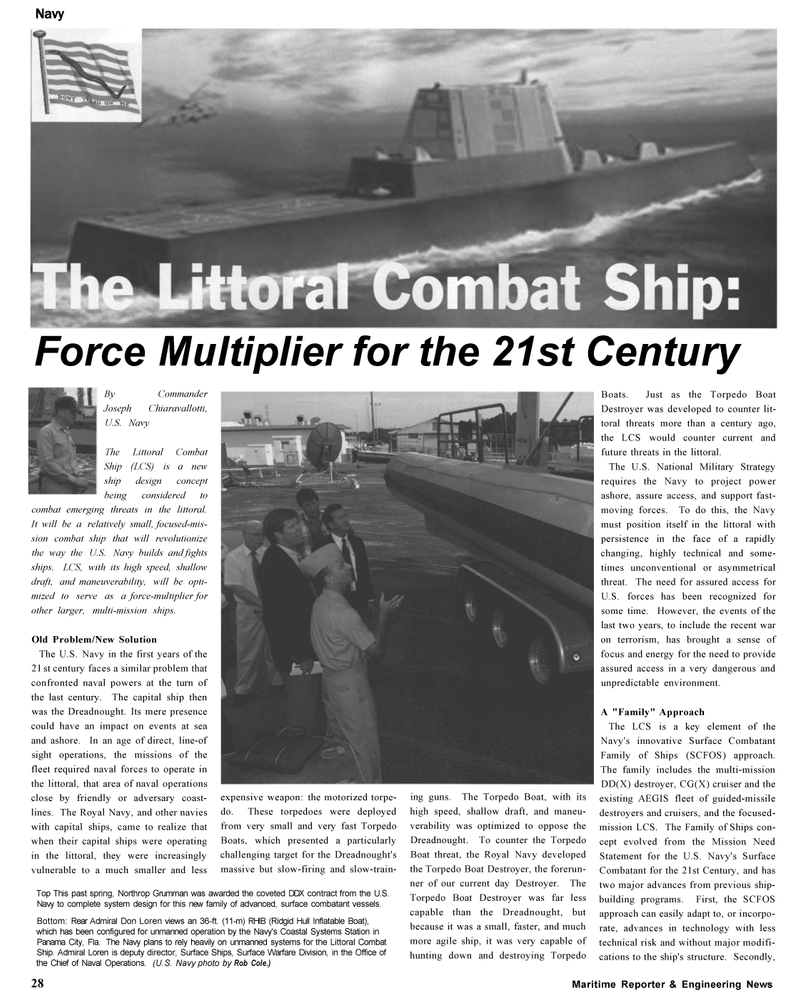
Page 28: of Maritime Reporter Magazine (October 2002)
Read this page in Pdf, Flash or Html5 edition of October 2002 Maritime Reporter Magazine
Navy
Force Multiplier for the 21st Century
By Commander
Joseph Chiaravallotti,
U.S. Navy
The Littoral Combat
Ship (LCS) is a new ship design concept being considered to combat emerging threats in the littoral.
It will be a relatively small, focused-mis- sion combat ship that will revolutionize the way the U.S. Navy builds and fights ships. LCS, with its high speed, shallow draft, and maneuverability, will be opti- mized to serve as a force-multiplier for other larger, multi-mission ships.
Old Problem/New Solution
The U.S. Navy in the first years of the 21 st century faces a similar problem that confronted naval powers at the turn of the last century. The capital ship then was the Dreadnought. Its mere presence could have an impact on events at sea and ashore. In an age of direct, line-of sight operations, the missions of the fleet required naval forces to operate in the littoral, that area of naval operations close by friendly or adversary coast- lines. The Royal Navy, and other navies with capital ships, came to realize that when their capital ships were operating in the littoral, they were increasingly vulnerable to a much smaller and less expensive weapon: the motorized torpe- do. These torpedoes were deployed from very small and very fast Torpedo
Boats, which presented a particularly challenging target for the Dreadnought's massive but slow-firing and slow-train-
Top This past spring, Northrop Grumman was awarded the coveted DDX contract from the U.S.
Navy to complete system design for this new family of advanced, surface combatant vessels.
Bottom: Rear Admiral Don Loren views an 36-ft. (11-m) RHIB (Ridgid Hull Inflatable Boat), which has been configured for unmanned operation by the Navy's Coastal Systems Station in
Panama City, Fla. The Navy plans to rely heavily on unmanned systems for the Littoral Combat
Ship. Admiral Loren is deputy director, Surface Ships, Surface Warfare Division, in the Office of the Chief of Naval Operations. (U.S. Navy photo by Rob Cole.) ing guns. The Torpedo Boat, with its high speed, shallow draft, and maneu- verability was optimized to oppose the
Dreadnought. To counter the Torpedo
Boat threat, the Royal Navy developed the Torpedo Boat Destroyer, the forerun- ner of our current day Destroyer. The
Torpedo Boat Destroyer was far less capable than the Dreadnought, but because it was a small, faster, and much more agile ship, it was very capable of hunting down and destroying Torpedo
Boats. Just as the Torpedo Boat
Destroyer was developed to counter lit- toral threats more than a century ago, the LCS would counter current and future threats in the littoral.
The U.S. National Military Strategy requires the Navy to project power ashore, assure access, and support fast- moving forces. To do this, the Navy must position itself in the littoral with persistence in the face of a rapidly changing, highly technical and some- times unconventional or asymmetrical threat. The need for assured access for
U.S. forces has been recognized for some time. However, the events of the last two years, to include the recent war on terrorism, has brought a sense of focus and energy for the need to provide assured access in a very dangerous and unpredictable environment.
A "Family" Approach
The LCS is a key element of the
Navy's innovative Surface Combatant
Family of Ships (SCFOS) approach.
The family includes the multi-mission
DD(X) destroyer, CG(X) cruiser and the existing AEGIS fleet of guided-missile destroyers and cruisers, and the focused- mission LCS. The Family of Ships con- cept evolved from the Mission Need
Statement for the U.S. Navy's Surface
Combatant for the 21st Century, and has two major advances from previous ship- building programs. First, the SCFOS approach can easily adapt to, or incorpo- rate, advances in technology with less technical risk and without major modifi- cations to the ship's structure. Secondly, 28 Maritime Reporter & Engineering News

 27
27

 29
29
